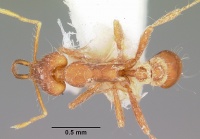Strumigenys asrochia
| Strumigenys asrochia | |
|---|---|

| |
| Scientific classification | |
| Kingdom: | Animalia |
| Phylum: | Arthropoda |
| Class: | Insecta |
| Order: | Hymenoptera |
| Family: | Formicidae |
| Subfamily: | Myrmicinae |
| Tribe: | Attini |
| Genus: | Strumigenys |
| Species: | S. asrochia |
| Binomial name | |
| Strumigenys asrochia Bolton, 2000 | |
The type material was collected from lowland forest litter samples.
Identification
Bolton (2000) - A member of the godeffroyi complex in the Strumigenys godeffroyi-group. See notes under Strumigenys confusatrix
Keys including this Species
Distribution
Distribution based on Regional Taxon Lists
Indo-Australian Region: Indonesia (type locality), Sulawesi.
Distribution based on AntMaps
Distribution based on AntWeb specimens
Check data from AntWeb
Countries Occupied
| Number of countries occupied by this species based on AntWiki Regional Taxon Lists. In general, fewer countries occupied indicates a narrower range, while more countries indicates a more widespread species. |

|
Estimated Abundance
| Relative abundance based on number of AntMaps records per species (this species within the purple bar). Fewer records (to the left) indicates a less abundant/encountered species while more records (to the right) indicates more abundant/encountered species. |

|
Biology
|
Castes
Nomenclature
The following information is derived from Barry Bolton's Online Catalogue of the Ants of the World.
- asrochia. Strumigenys asrochia Bolton, 2000: 787, figs. 431, 493 (w.q.) INDONESIA (Sulawesi).
Unless otherwise noted the text for the remainder of this section is reported from the publication that includes the original description.
Description
Worker
Holotype. TL 2.5, HL 0.68, HW 0.44, CI 65, ML 0.33, MI 49, SL 0.42, SI 95, PW 0.27, AL 0.66. Characters of godeffroyi-complex. Cephalic dorsum with pair of erect hairs closest to midline on occipital margin minutely looped apically or with the extreme apex abruptly angled anteriorly (apices broken off in many paratypes so that hairs appear straight). With head in full-face view the dorsolateral margin posterior to the apicoscrobal flagellate hair has a row of 3-4 stiffly projecting hairs. These hairs contrast with the marginal hairs anterior to the flagellate hair as they are more cylindrical (i.e. not spatulate), more elevated and less strongly curved anteriorly. Ground-pilosity on pronotal dorsum sparse and inconspicuous. Dorsum of pronotum with a pair of erect long flagellate hairs as well as the humeral pair. Entire side of alitrunk densely reticulate-punctate, usually without smooth patches anywhere but in some paratypes a small median patch on katepisternum more or less smooth. Propodeal declivity with a broad conspicuous lamella. Propodeal teeth strongly developed at dorsal apex of lamella and dorsal surface of tooth in profile not surmounted by a convex crest or ridge of spongiform tissue. Disc of postpetiole densely reticulate-punctate. Basigastral costulae conspicuous but not extending half the length of the tergite.
Paratypes. TL 2.5, HL 0.68-0.69, HW 0.44-0.49, CI 64-67, ML 0.31-0.34, MI 47-50, SL 0.40-0.42, SI 89-95, PW 0.27-0.28, AL 0.66-0.70 (10 measured).
Type Material
Holotype worker, Indonesia: Sulawesi Utara, Dumoga-Bone N. P., 200-400 m., ii.1985, 2m2 sample of litter, lowland forest, BB2 (P.M. Hammond) (The Natural History Museum).
Paratypes. 8 workers and 1 queen with same data as holotype; 3 workers with same data but BB1, 3 workers with same data but BB3; 9 workers with same data but BB7 (BMNH, Museum of Comparative Zoology, Musee d'Histoire Naturelle Genève).
References
- Bolton, B. 2000. The ant tribe Dacetini. Memoirs of the American Entomological Institute. 65:1-1028. (page 787, worker described)
References based on Global Ant Biodiversity Informatics
- Bolton B. 2000. The ant tribe Dacetini. Memoirs of the American Entomological Institute 65: 1-1028.

